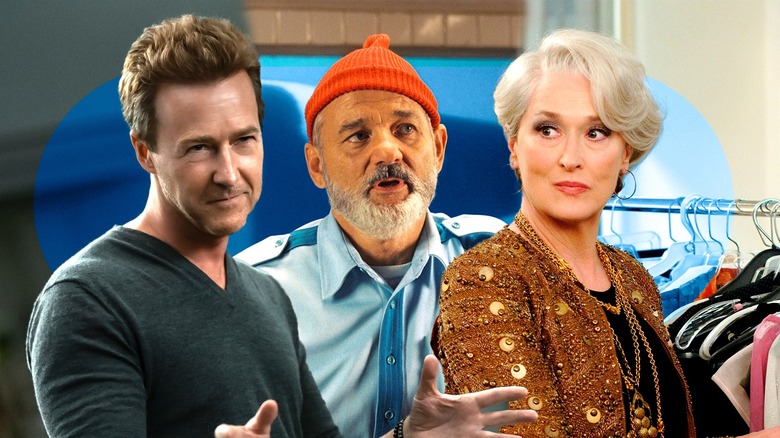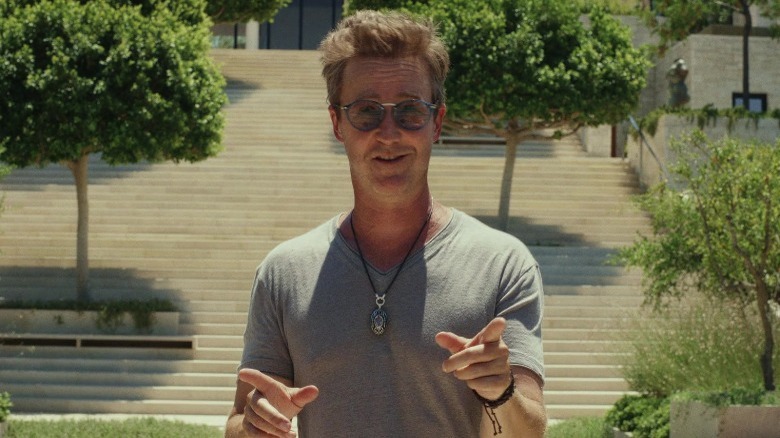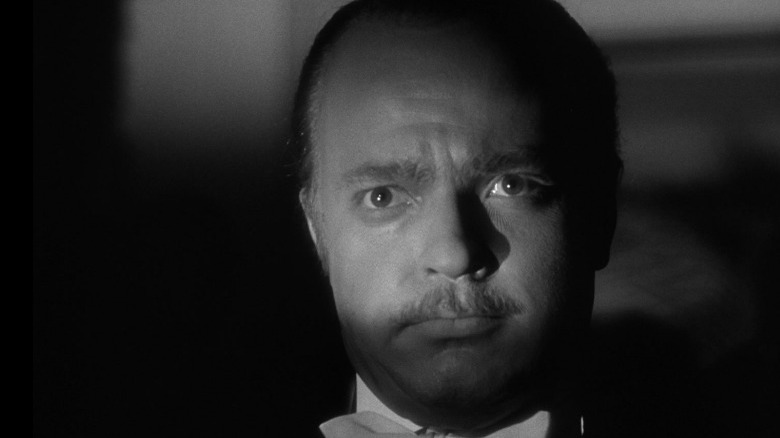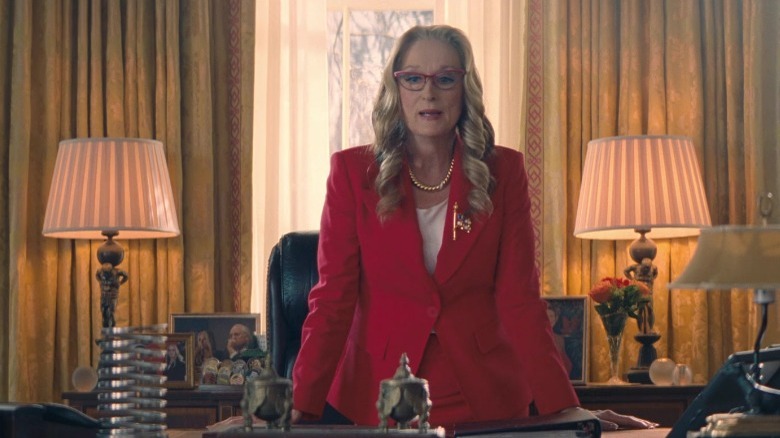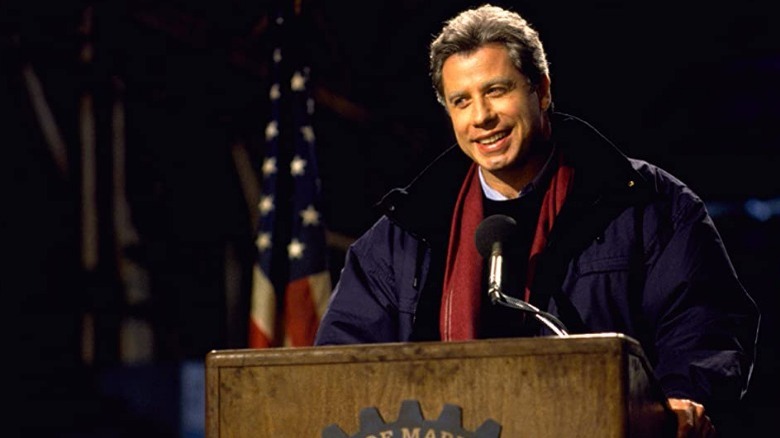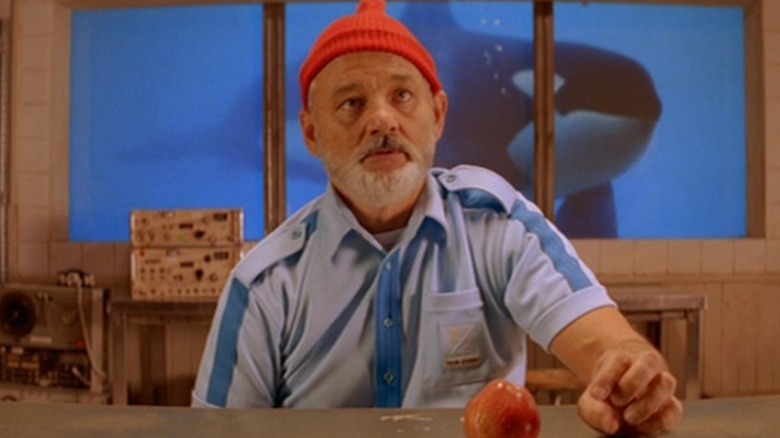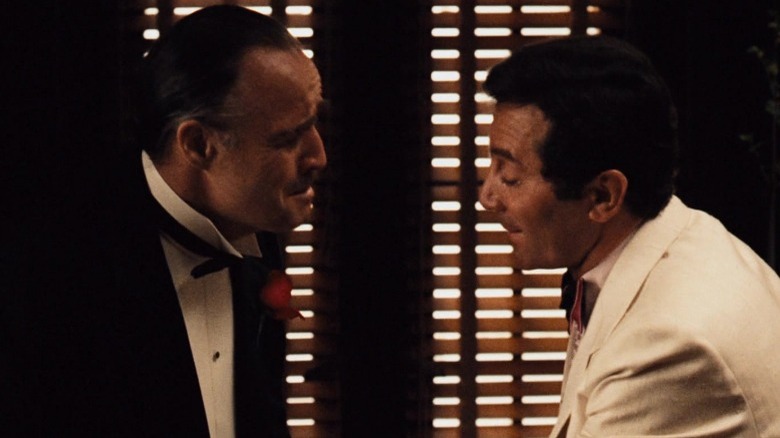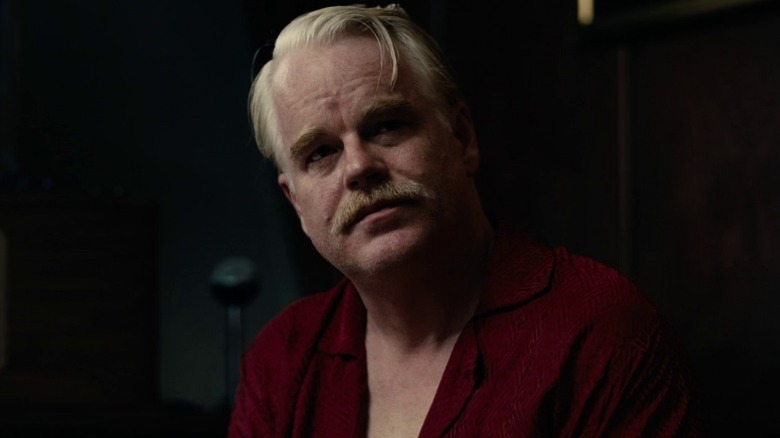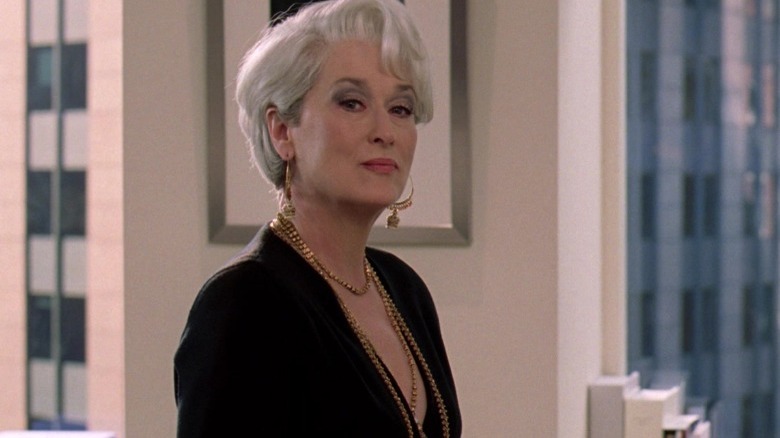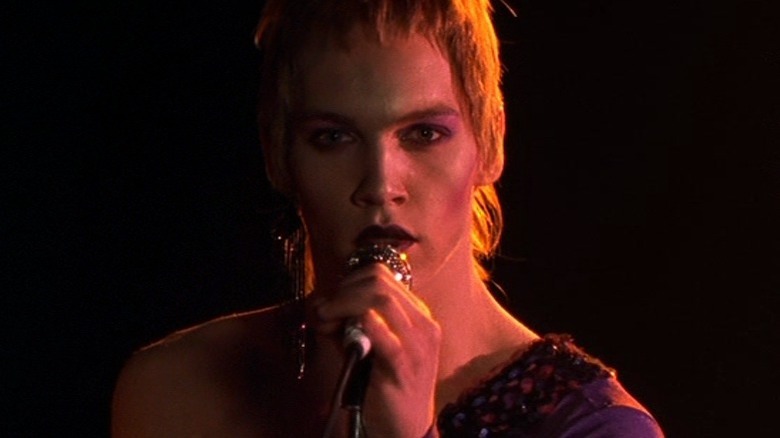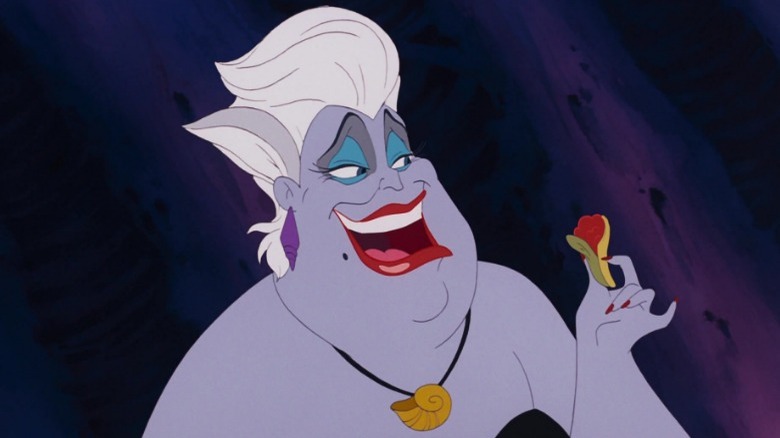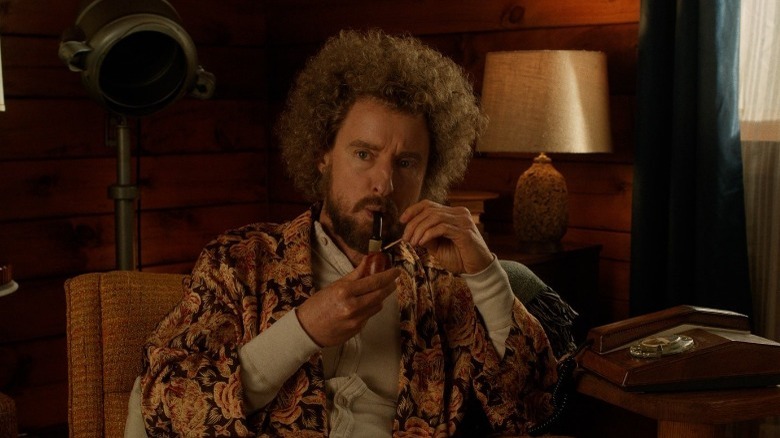Movie Characters Who Were Clearly Based On Celebrities
Suppose you want to make a movie that criticizes a real-life famous person, but you don't want to make a documentary about them, and you definitely don't want to get sued. How can you pull it off? Simple. Just change a few names, fudge a few details, and voilà — you've got a thinly-veiled parody. Nobody will be the wiser, right?
Well, we can't guarantee that your audience won't know right away who your film is really about — and sometimes the celebrity in question will still hate your portrayal of them. But in most cases, you'd be okay, because your movie would fall squarely in the realm of fiction. Creating characters who are obviously based on celebrities is a classic filmmaking tradition. Orson Welles got away with it, and so did Francis Ford Coppola, so you'd be in good company.
There are countless movie characters who were clearly based on real people, but here are some of the most famous and obvious examples. Whether these characters are from serious dramas about not-quite-fictional people or hilarious satires of celebrities, you'll be able to tell from a mile away who they are really supposed to be.
Miles Bron - Glass Onion: A Knives Out Mystery
Make no doubt about it: Miles Bron (Edward Norton) from "Glass Onion: A Knives Out Mystery" is essentially Elon Musk. Director Rian Johnson has insisted that the character isn't directly based on Elon Musk – at least not only Elon Musk. According to Johnson, Bron is a satire of billionaire tech giants in general, not any particular person. Norton added that any billionaire could see themselves in Bron, and he implied that if they did, then it would probably be due to their inflated self-importance. "I think it's sort of like Carly Simon's song 'You're So Vain (You'll Probably Think This Song is About You),'" he told /Film.
Still, the parallels are hard to ignore. For one, Bron claims to have single-handedly created Alpha and denies that Andi (Janelle Monáe) contributed to the project. Audiences can't help but think of Elon Musk, who has an ongoing feud with Martin Eberhard about who deserves credit for founding Tesla. What's more, Bron launches his new technology Klear before it's been properly tested, even though scientists warn him it's too dangerous. This also screams Musk, who current and former employees have described as not grasping the technological infrastructure of Twitter and ignoring the advice of those that did. After shutting Andi out of the company, Bron coerces his other partners to fall in line, which definitely calls to mind Musk's ultimatum for all employees to agree to the new working conditions of Twitter 2.0 or else be fired.
So is he meant to be Musk? You be the judge.
Charles Foster Kane - Citizen Kane
Cinema has a long history of thinly-veiled jabs at celebrities, going all the way back to the earliest decades of film. The character Charles Foster Kane (Orson Welles) from "Citizen Kane" was undeniably meant to represent media mogul William Randolph Hearst. Like Hearst, Kane becomes wealthy at a young age, and he soon builds a newspaper business into a media empire. Also like Hearst, Kane often retreats to an extravagant mansion with an equally extravagant name.
One of the biggest parallels can be seen in Kane's mistress Susan (Dorothy Comingore), who is clearly based on actress Marion Davies. Like Susan, Davies was a rising performer with a wealthy benefactor who pulled some strings to boost her career, without really asking what she wanted. Hearst urged Davies to take dramatic roles, even though she preferred doing comedies — much like Susan, who was pushed into the spotlight as an opera singer despite her vocal limitations.
While screenwriter Herman J. Mankiewicz knew Hearst personally, Welles had never met Hearst. At least not until the film's premiere, when Welles bumped into Hearst in an elevator and asked if the man planned to watch "Citizen Kane." Still sour about his unflattering portrayal in the film, Hearst said nothing, to which Welles allegedly replied, "Well, Mr. Kane would have come."
Of course, if you thought Kane was obvious, Mankiewicz also wrote another parody that was even more thinly veiled: the villain of his unproduced script "The Mad Dog of Europe" was a fellow called "Adolf Mitler."
President Orlean - Don't Look Up
President Orlean (Meryl Streep) from "Don't Look Up" is hardly the first movie parody of Donald Trump. The tradition dates all the way back to Biff Tannen from "Back to the Future Part II". However, Orlean might be the first female character who is instantly recognizable as Trump.
The connections are obvious. Using their celebrity as a reality TV star to build their presidential platform? Check. Appointing unqualified people to government offices, including members of their own family? Double-check. The way Orlean dismisses the looming threat of the comet out of fear it will hurt her reelection campaign will feel all too familiar to anyone who followed Trump's initial response to the COVID-19 epidemic. In fact, the way that Orlean flat-out denies scientific facts whenever it's not convenient for her is a trait that consistently mirrors Trump's stance on climate change. It's also worth noting that Orlean encourages her supporters to chant slogans that don't make a lick of sense if you stop and think about them. In that respect, "Don't look up!" isn't too far removed from "Stop the steal!"
Of course, while Trump was the main inspiration, he wasn't the only basis for Orlean's character, director Adam McKay told The Los Angeles Times. "I wanted her to be a kind of a stew of all the disastrous presidents we've had," he explained.
Jack Stanton - Primary Colors
On the other side of the political spectrum, there's John Travolta's character from the film "Primary Colors." The Democratic governor named Jack Stanton (Travolta) who is running for president may seem awfully familiar to viewers. From his graying hair and Southern accent to his squinty look of contemplation, his appearance and mannerisms are a dead ringer for Bill Clinton.
However, the similarities go beyond just a mere impression. Like Clinton, Stanton carefully cultivates a charismatic and down-to-earth public persona, yet has skeletons in his closet that his political rivals don't hesitate to dig up. For Stanton, it's a rumored affair with a woman named Cashmere McLeod (Gia Carides); for Clinton, it was a similar scandal with Gennifer Flowers. Both women were lounge singers, and both went public with audio tapes of a conversation with the presidential candidate.
Emma Thompson's character is equally comparable to Hilary Clinton, especially in her reaction to her husband's affair: giving him her grudging support, despite being rightfully upset with him, because she wants his campaign to succeed.
Although the movie focuses on the scandals surrounding Clinton during his 1992 presidential campaign, they soon became overshadowed by the Monica Lewinsky scandal that broke out in 1998, right around the movie's release. The film's timing couldn't have been more perfect if they planned it.
Steve Zissou - The Life Aquatic with Steve Zissou
Anyone who watches "The Life Aquatic with Steve Zissou" will notice that the titular oceanographer has some obvious parallels to the real-life Jacques Cousteau. Much like Steve Zissou (Bill Murray), Cousteau filmed documentaries about ocean wildlife on a private boat equipped with a bright yellow submarine. (There's a clever pun embedded in the movie. Cousteau's ship was called the Calypso, while in the movie it's called the Belafonte, named for the calypso singer Harry Belafonte.) But the real clincher is Zissou's droopy red beanie, which looks identical to the one Cousteau often wore. Divers needed to wear hats like these inside their helmets to keep warm, since early diving helmets couldn't effectively keep out the chill of the ocean.
In a 2009 interview at the New York Public Library, director Wes Anderson admitted that, yeah, his character was based a teensy bit on Jacques Cousteau. Anderson recalled that the film's distributor, Touchstone Pictures, had struggled with a delicate legal dilemma. "They didn't feel like we could release this film with this glaring legal lapse," he explained, "but they also didn't want to call it to the attention of the Jacques Cousteau family." According to Anderson, Touchstone ultimately decided to approach the Cousteau family, saying, "We would like to give you $200,000 not to sue us, if you think this is illegal." Apparently, the Cousteau family didn't have any issues with this, because they accepted the money and gave the film their approval.
Johnny Fontaine - The Godfather
If you haven't already guessed, the crooner Johnny Fontaine (Al Martino) from "The Godfather" is based heavily on Frank Sinatra. Like "Citizen Kane," "The Godfather" depicts a celebrity relying on a wealthy benefactor to get gigs. Here, Fontaine complains to Vito Corleone (Marlon Brando) that his music career is in decline but a role in a movie would turn it around, so he asks Corleone to pull some strings in Hollywood. Corleone promises he'll approach the studio head and "make him an offer he can't refuse." And by that, of course, he means "threaten at gunpoint."
Naturally, Sinatra didn't like the implication that he only got his role in the film "From Here to Eternity" due to his mob connections (as opposed to actual talent). He tried to stop "The Godfather" from being filmed and even publicly confronted the author of the original book. However, some would argue that "The Godfather" was right on the money about Sinatra's ties to the mob. Sinatra previously performed for band leader Tommy Dorsey, but when Sinatra wanted to leave for greener pastures, Dorsey wouldn't let him exit his contract — at least until Sinatra called in a favor with his godfather Willie Moretti, who is rumored to have made Dorsey an offer he couldn't refuse, Corleone-style. This story is described almost beat-by-beat in the scene where Michael Corleone (Al Pacino) explains how his father helped Fontaine's career.
Coincidence? We think not.
Lancaster Dodd - The Master
Paul Thomas Anderson made no effort to hide his inspiration for the film "The Master." At a press conference in Venice (via Indiewire), Anderson openly acknowledged that his character Lancaster Dodd (Philip Seymour Hoffman) was based directly on the real-life founder of Scientology. "I based it on L. Ron Hubbard," he said, "[and much of the film] related to the early days of Dianetics." Of course, Anderson clarified that Dodd isn't an exact representation of Hubbard or Scientology; instead, he simply wanted to "use it as a backdrop for these characters."
Nevertheless, you could fill a book with all the things that Hubbard and Dodd have in common. Both build a new religion around the concept of reincarnation and publish books on the subject. Dodd also practices a psychological exercise known as "processing," in which he prods subjects like Freddie (Joaquin Phoenix) to relive their most traumatic and uncomfortable memories until the memories no longer bother them. This process is uncannily similar to the procedure called "auditing" in Scientology.
Another parallel is the friction between Dodd and his children. In the movie, Dodd's son (Jesse Plemons) openly denounces his father's beliefs, insisting that he's "making all this up as he goes along." Likewise, Hubbard's son went on to publicly criticize his father, insisting that his father didn't care about helping his followers, according to Penthouse (via Cult Education Institute).
If you or someone you know is dealing with spiritual abuse, you can call the National Domestic Violence Hotline at 1−800−799−7233. You can also find more information, resources, and support at their website.
Miranda Priestly - The Devil Wears Prada
Miranda Priestly from "The Devil Wears Prada" is another clever parody portrayed by Meryl Streep. The character is based heavily on Vogue fashion editor Anna Wintour, from the unspoken dress code she expected her assistants to follow, to her insistence on eating a fancy steak for lunch each day. Wintour's former assistant Meredith Asplundh revealed that she was expected to remain behind the desk at all times, even if she needed to use the bathroom. The similarities to Wintour were so obvious that most folks in the fashion industry were afraid to participate in the film, lest they incur Wintour's wrath. Supermodel Gisele Bündchen told Entertainment Weekly, "Anna was the final word, and everyone wanted to please her."
Director David Finkel shared in the same interview that he modeled Priestly's office after Wintour's. In order to recreate the office, he sent production designer Jess Gonchor to take a peek at Anna Wintour's office (presumably without revealing his real intentions for being there). Later Wintour must have figured out what the film crew was up to, because Finkel recalled, "I was told Anna redecorated [her office] immediately after the movie came out."
For her part, Wintour seems comfortable joking about the film more than a decade after its release. In a 2022 interview with Vogue, when asked who she would want to play her in a Broadway musical about her life, Wintour said simply "Meryl Streep." It's unclear if she liked Streep's portrayal or was simply being facetious.
Brian Slade - Velvet Goldmine
The glam rock singer Brian Slade from "Velvet Goldmine" wasn't originally meant to be based on David Bowie. In earlier versions of the film, he was supposed to be David Bowie. However, director Todd Haynes needed to make a U-turn after the real Bowie wouldn't let Haynes use his songs in the movie and threatened to sue.
Thus Bowie became the fictional Brian Slade, though many of the parallels are still there. Slade creates the stage personas Maxwell Demon and Tommy Stone to reinvent himself, not unlike the way David Bowie embraced his various personas like Ziggy Stardust and The Thin White Duke — though Bowie never went so far as to stage a fake assassination like Slade. The style of Slade's makeup and costumes will immediately make viewers think of Bowie, along with the character's open bisexuality. There's even a stand-in for Bowie's ex-wife Angela with Toni Collette's character Mandy.
In retrospect, Haynes is actually glad he wasn't allowed to make a Bowie biopic. Haynes ended up taking the character in a fictional direction, making Slade a symbol of the entire glam rock era, and he feels the movie is stronger for it. "If there [was] ever a chance to read the Brian Slade character a little bit more fluidly," he told the British Film Institute, "having him sing Bowie songs would have sealed that off completely."
Ursula - The Little Mermaid
Fans may not be aware that a certain Disney princess starred opposite a drag queen — or at least, a character inspired by a drag queen. Ursula (Pat Carroll) from "The Little Mermaid" was clearly based on Divine, a performer known for "Pink Flamingos" and "Hairspray." You'll recognize it right away if you consider Ursula's heavy eyeshadow and arched eyebrows, not to mention her iconic throaty laugh. Once viewers see the connection, they won't be able to unsee it.
Unbelievable as it may seem, Disney actually knew what it was doing when it modeled this villain after a drag queen. The animators brainstormed countless designs for the sea witch, but none of them were clicking until one sketch done by animator Rob Minkoff caught Ashman's eye. Ashman loved the design, declaring, "She looks like a Miami Beach matron" (per Hazlitt). That was when the filmmakers decided to lean into the connection to Divine. "The Little Mermaid" became a huge hit and revived the dying studio.
It's worth noting that this wasn't even Divine's first time playing a campy creature of the sea: He also played a crab in an underground drag show called "Journey to the Center of Uranus."
Carl Nargle - Paint
Out of all the movie characters who were clearly based on celebrities, perhaps none wear their influences on their sleeve as much as Carl Nargle (Owen Wilson) from "Paint." Of course, the most obvious clue is not on Carl's sleeve, but on his head. When you see Carl's hair — a poofy perm that forms a halo around his head — it's impossible not to think of Bob Ross. Other details about Carl's character underscore the connection. Both are landscape painters who star in their own PBS show, and both are known for their soothing voices and laid-back vibe. (Though, if you want to split hairs, Ross filmed most of his show in Muncie, Indiana, while Carl is based in Vermont.)
Yet the similarities stop there. Certainly, "Paint" contains an archetype that resembles Ross, but the movie takes the character in a purely fictional direction. Carl's arrogance and his rivalry with a younger painter are not drawn from anything in Ross's life. Director Brit McAdams didn't set out to write a film about Bob Ross – just a character who seemed like Ross on the surface. In fact, Ross wasn't even that popular at the time when McAdams first wrote the script. "It's funny," McAdams told MovieMaker. "When I wrote it, Bob Ross really wasn't a thing ... So it's been really odd to see him have this resurgence." It turned out to be the perfect time for him to introduce the world to Carl Nargle.
